Unsure about your French table manners? Click Here to download > > How to avoid these 10 food etiquette mistakes !
- Home ›
- Destinations ›
- Best Small Villages in France for Summer
7 Most Beautiful Small Villages In France To Visit In Summer
Published 18 April 2025 by Leyla Alyanak — Parisian by birth, Lyonnaise by adoption, historian by passion
France has hundreds of remarkable villages, including an official list of the most beautiful. I've selected a few favorites for their beauty, history, architecture, or heritage. With summer approaching, this list of top villages in France includes my top picks to explore.
The title of this story is a bit misleading — I mention 7 villages, but in fact, some of the listings cover an area which contains several of the most beautiful small villages in France.
So if you do the math properly, you're actually getting more than a dozen villages.
I hope you don't mind.
NOTE: Pages on this site may contain affiliate links, which support this site. See full Privacy Policy here.
They don’t call them "les plus beaux villages de France" for nothing — or, in translation, the most beautiful villages in France, an association dedicated to preserving particularly noteworthy village heritage and architecture.
They're tucked between lavender fields, clifftop fortresses and gorgeous cobblestones, often looking like they're emerging from a medieval daydream.
They are popular, however, and popularity breeds crowds but even so, they're worth a visit. I'll provide tips for each village about the best times to visit and how to avoid the crowds, so don't let that scare you!
1. Basque Villages
The Basque interior holds some of the most striking villages on the Plus Beaux Villages de France list.
Ainhoa stands out for its perfect alignment of traditional Basque houses along a single main street — whitewashed walls, red timbers, and the feeling you may have crossed the border into Spain without quite realizing it.
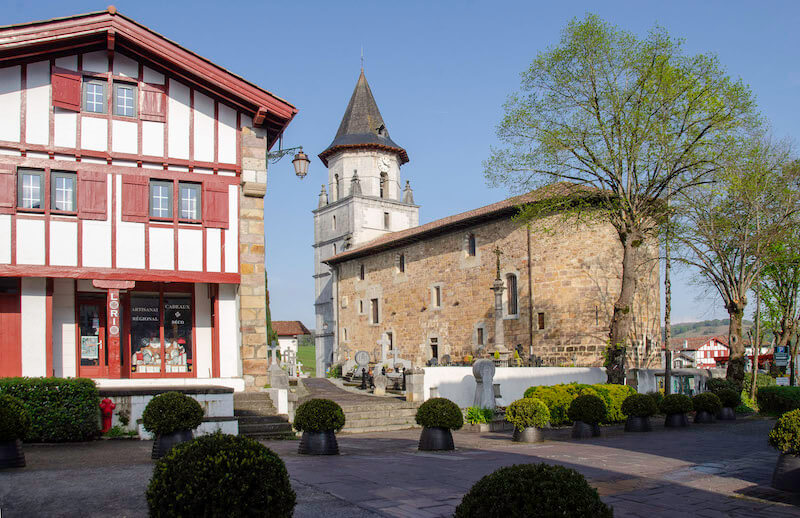 Typical Basque house in Ainhoa, France's Basque country
Typical Basque house in Ainhoa, France's Basque countrySare is equally authentic, with its pelota court on the main square, 17th-century homes marked by carved stone lintels, and a network of caves just outside the village that dates back to prehistory.
Saint-Jean-Pied-de-Port was once a stronghold of the Kingdom of Navarre, but it’s now a major waypoint on the Camino de Santiago. Its cobbled main street climbs past fortified gates, a Gothic church, and up to a hilltop citadel reworked by Vauban, the famous engineer under Louis XIV.
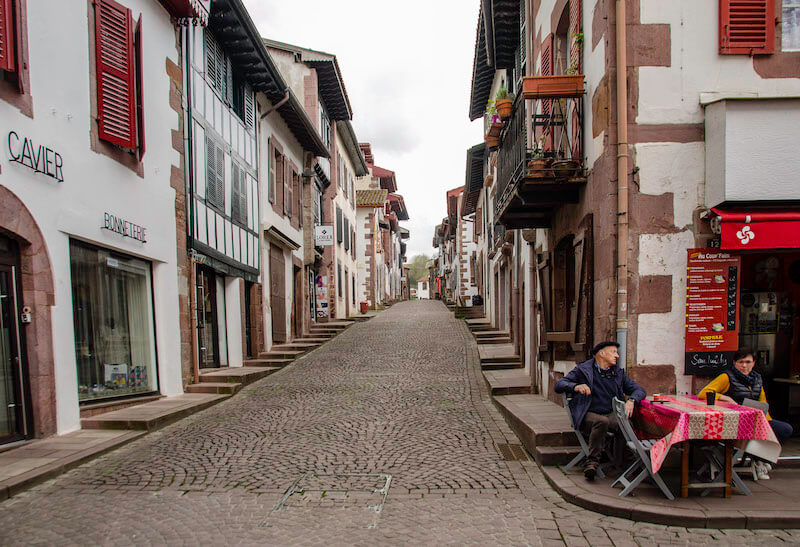 Classic village street in St-Jean-Pied-de-Port ©OffbeatFrance
Classic village street in St-Jean-Pied-de-Port ©OffbeatFranceEach of these villages offers a different facet of the Basque country's identity, and I've prepared an itinerary you could follow if you decide to include this less-visited region on your summer itinerary.
TOP SUMMER TIPS IN THE BASQUE REGION
- Beauty: think whitewashed houses with red or green shutters glowing under the summer sun
- Village festivals (site in French), like the Fêtes de Sare, that showcase traditional Basque music, dance, and pelota games
- Local produce, like piment d’Espelette and Basque cheese, is in full season
Watch out for: humidity, especially in August, and spillover from the popular coast nearby. Visit in late June or early July to enjoy lively village life before peak tourist season. Stay inland to avoid inflated prices. And bring a light rain jacket — this is green country for a reason.
2. Flavigny-sur-Ozerain
Flavigny-sur-Ozerain is a delightful walled medieval village in Burgundy best known for two things: its aniseed candies, made by monks for centuries, and its role as the filming location for the movie 'Chocolat'.
But despite the brush with Hollywood, the village hasn’t turned itself into a film set at all. Its cobbled lanes, Romanesque buildings and fortified gates are the real thing.
Summer is ideal for a visit — not just for the weather, but because the village fully opens up: the candy factory, the small museums, the abbey grounds.
Walk along the ramparts, breathe in the scent of anise, and you'll understand why Flavigny earned its spot on the Plus Beaux Villages list.
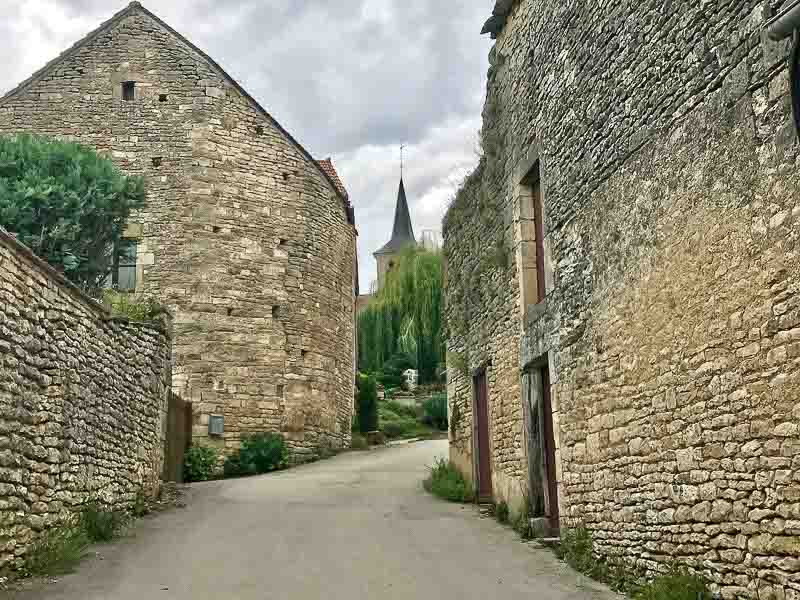 A medieval street in the village of Flavigny-sur-Ozerain ©OffbeatFrance
A medieval street in the village of Flavigny-sur-Ozerain ©OffbeatFranceTOP SUMMER TIPS IN FLAVIGNY-SUR-OZERAIN
- The golden light in summer
- The scent of aniseed
- Art exhibitions, antique fairs, cozy music festivals
Watch out for: the midday heat — Burgundy is famous for it, and there isn't much shade in the village. Plan strolls for morning or evening, and book lunch indoors — some cafés close midday. Consider bringing your own shade (a parasol or hat) and water bottle. Accommodations are limited, so book early.
3. Les Baux
Les Baux-de-Provence is no secret, but its setting still manages to stun you as you drive up the road and the fortress emerges at the top.
Perched on a rocky outcrop in the Alpilles, the village looks down on a vast Provençal plain. It’s also one of the most visited "Plus Beaux Villages" in France, known for its old stone structures and panoramic views.
So yes, there will be crowds during summer days.
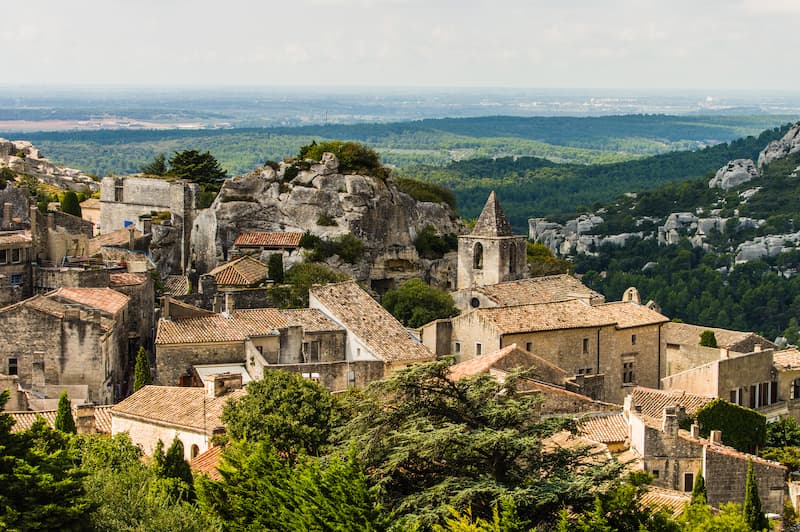 View of Les Baux from above
View of Les Baux from aboveBut just below the village, carved into the rock itself, is where you'll find respite from the summer sun in one of its most remarkable sights: the Carrières des Lumières.
Once a limestone quarry, this is now an immersive art space where moving images are projected onto the stone walls, ceilings, and floors. The scale is monumental and the effect unforgettable. I've seen several shows here and it's an ideal summer visit — in the heat of summer, the cool, cavernous interior offers a welcome break from the heat outside.
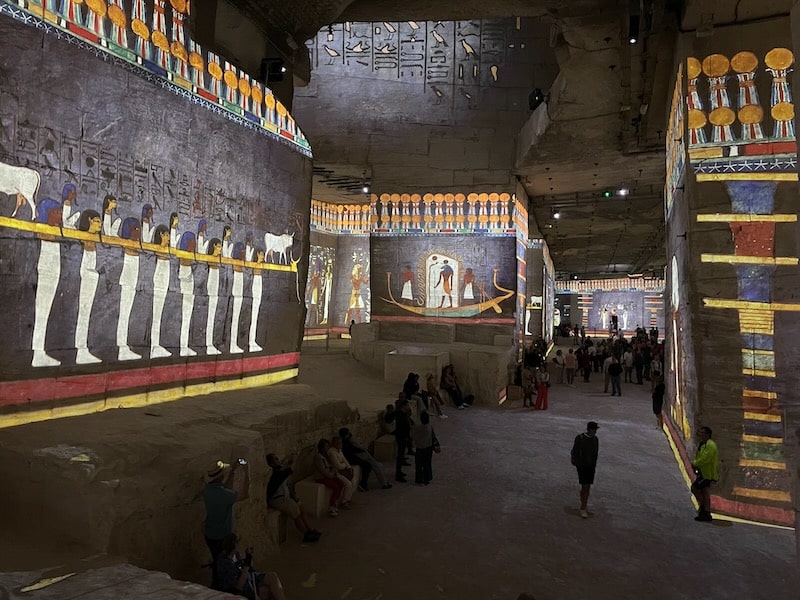 This particular show in the Carrières was dedicated to Egypt's Pharaos – often, shows deal with artists like Dali or Monet ©OffbeatFrance
This particular show in the Carrières was dedicated to Egypt's Pharaos – often, shows deal with artists like Dali or Monet ©OffbeatFranceTOP SUMMER TIPS IN LES BAUX-DE-PROVENCE
- The Carrières de Lumières digital art show takes place inside cool stone quarries and is a fabulous way to hide from the heat (not to mention a world-class experience).
- The stunning view from the medieval citadel over the Alpilles in the golden summer light.
Watch out for: Crushing crowds and unforgiving heat. The stone village reflects sunlight like a mirror. Parking is often a nightmare by late morning, so visit at opening time (9am). While many people will tell you to head to the Carrières first, I suggest the opposite: wander around the village before the surge in crowds, and when you're wilting in the heat, head for the coolness of the Carrières. Don't forget to book your ticket ahead of time. And avoid August, which is both the hottest and the most crowded month.
4. Small French villages in the Luberon
The Luberon is packed with beautiful villages, but five of them carry the official label of most beautiful village of France — and each earns it in a different way.
Ansouis is the quiet one, all understated charm and winding lanes, anchored by a château that hides a medieval fortress inside its Renaissance shell. You won't find huge crowds here.
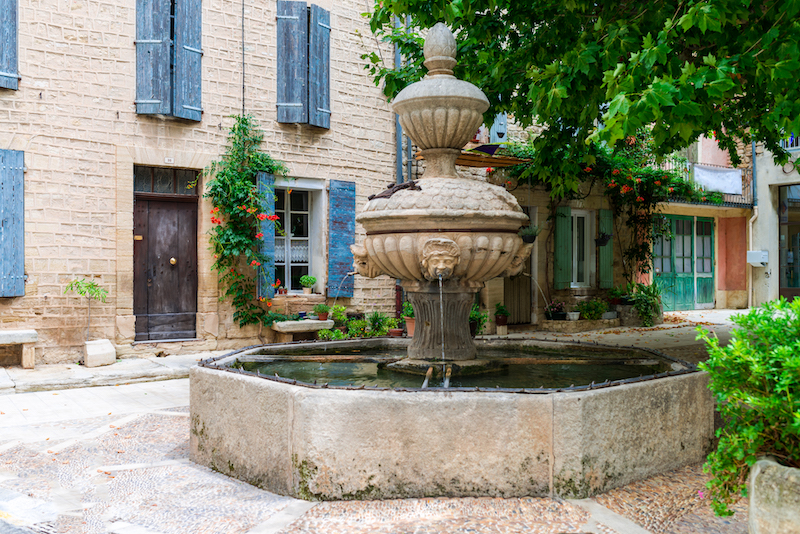 Ansouis, more quiet than its neighbors ©OffbeatFrance
Ansouis, more quiet than its neighbors ©OffbeatFranceGordes, perched dramatically on a cliff, is impressive with its dry stone walls, vaulted alleys, and the underground caves of the Palais Saint-Firmin. The Saturday morning market does draw crowds but again, an early or late arrival means you'll get more beauty with fewer crowds.
Lourmarin brings a quirkier vibe, with its Renaissance château, Protestant past, and an artsy pulse that you can still feel. This is a popular village, not only among foreigners — plenty of French tourists come here too, for a great foodie scene and plenty of quaint shops.
Ménerbes, long and narrow along a ridge, is drenched in Huguenot history and postwar creative energy — Picasso bought a house here for Dora Maar. If the name of the village sounds familiar, it's probably because this was the home of Peter Mayle, who, for better or worse, popularized the Luberon well beyond France's borders.
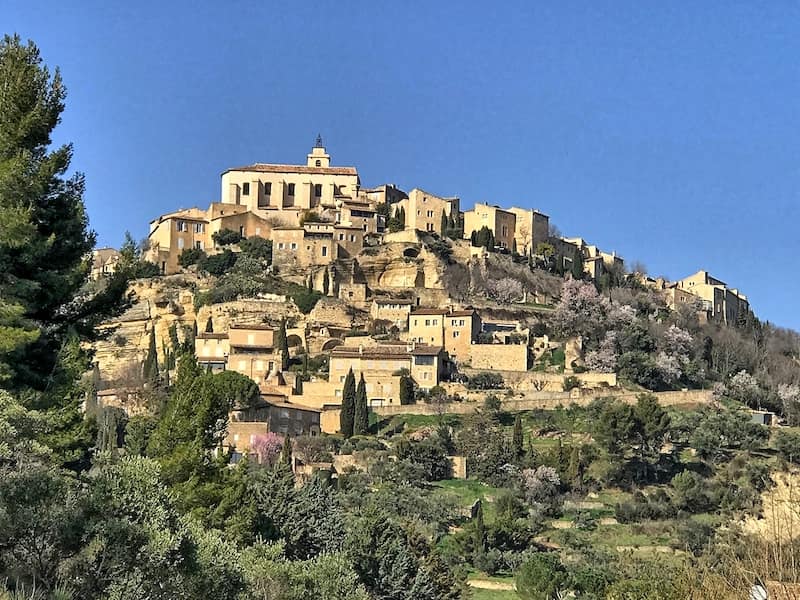 The classic shot of Gordes from the road below ©OffbeatFrance
The classic shot of Gordes from the road below ©OffbeatFranceAnd Roussillon, impossible to miss, is drenched in ochre — walls, cliffs, even the footpaths — thanks to its former pigment quarries.
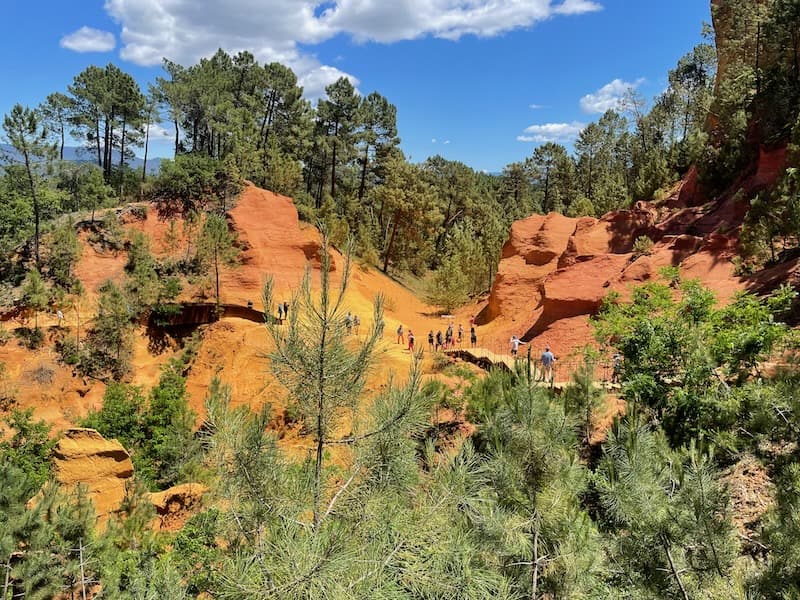 Not only is the village itself painted mostly ochre, but the Ochre Trail takes you through the former quarries into a land of unbelievable color ©OffbeatFrance
Not only is the village itself painted mostly ochre, but the Ochre Trail takes you through the former quarries into a land of unbelievable color ©OffbeatFranceEach of the villages is different, and each deserves its place on the list. In summer, they come alive: cafés spill into the streets, trails open up, and the colors — especially in Roussillon — reach their peak under the sunshine of Provence.
TOP SUMMER TIPS IN THE LUBERON
- The lavender fields! They bloom from late June to mid-July
- Village markets overflow with peaches, figs, olives
- Long evenings are for lingering with rosé on shaded terraces
- Roussillon’s ochre cliffs and Gordes’ white stones absolutely shimmer in the summer sun.
Watch out for: Yes, there are plenty of tourists, especially on market days. Roads can be congested and parking stressful. Lavender fades by mid-July, so visit early July for peak lavender. Base yourself in one of the less touristy villages like Bonnieux to avoid tourist choke points. Use early mornings to explore, and mid-afternoons to rest indoors or by the pool.
5. Oingt
Oingt (pronounced roughly wang but without the "G" — good luck with that) is one of the most striking villages in the Beaujolais, perched high on a ridge and built entirely from golden limestone.
It’s part of the Pierres Dorées region — literally “golden stones” — and in summer, the light catches every façade, making the entire village glow.
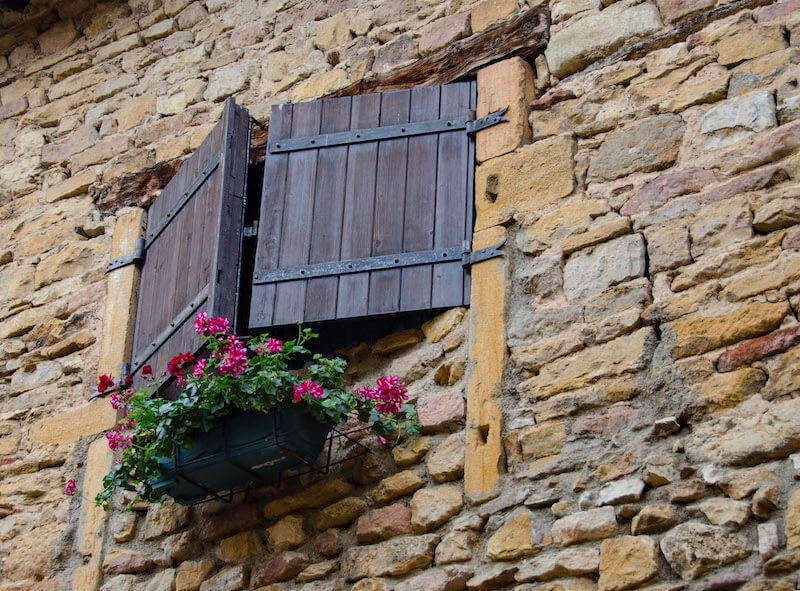 A view of the golden stones of Oingt, in the Beaujolais region outside Lyon ©OffbeatFrance
A view of the golden stones of Oingt, in the Beaujolais region outside Lyon ©OffbeatFranceIt’s an ideal stop along the Beaujolais wine route, with panoramic views over rolling vineyards and a warren of cobbled lanes lined with artists’ studios and wine shops.
While the village dates back to at least the 11th century, what stands out is the sense of timelessness: the sun caressing the stone, shutters cracked open, and the distant hum of a tractor somewhere in the vines.
TOP SUMMER TIPS IN OINGT
- This golden-stone village glows at sunset and the evening light is magical
- Vineyards burst with color
- It's quieter than the villages of Provence
- Enjoy the summer wine events and medieval festivals of the Beaujolais region
Watch out for: There's very limited public transport and few shops are open after 6pm. Evenings can be eerily quiet. Rent a car to explore nearby wine villages and ask locals about vineyard tastings, which are often informal. Reserve your evening meal because there are few options and they go fast.
6. Pérouges
Just over an hour from Lyon, Pérouges is the medieval village that came back from the brink.
By 1900, its houses were crumbling, its population dwindling, and demolition crews had started carting off its stonework. Then came the rescue: a group of Lyonnais intellectuals bought and restored it, house by house.
Today, Pérouges is a living monument, a perfect day trip from Lyon — and yes, one of France’s officially “most beautiful villages.”
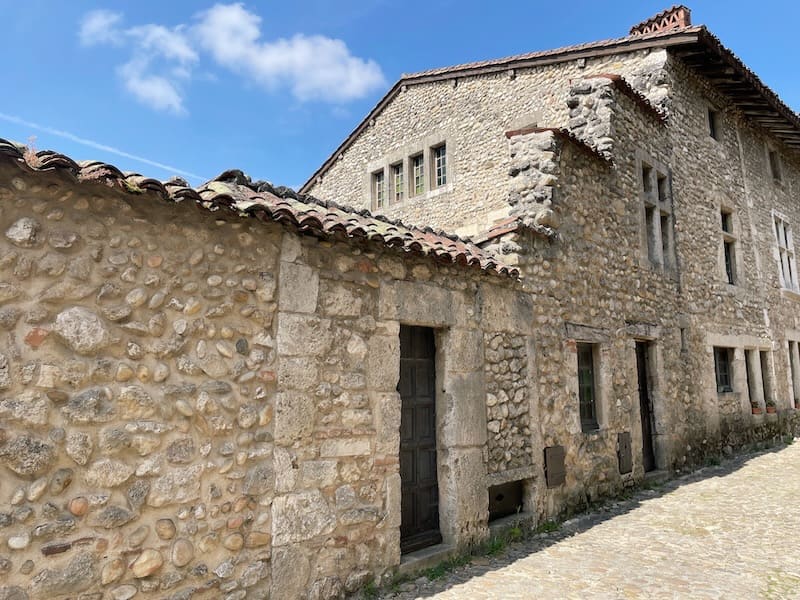 Stonework of Pérouges, the village that was almost razed
Stonework of Pérouges, the village that was almost razedIn summer, the golden light on the rounded cobblestones is best appreciated early, before the crowds. Walk the ramparts, explore artisan shops, and don’t leave without tasting the famous galette de Pérouges, a crisp sugar-dusted tart created during the village’s rebirth to charm visiting city folk.
It worked. People still come for a taste.
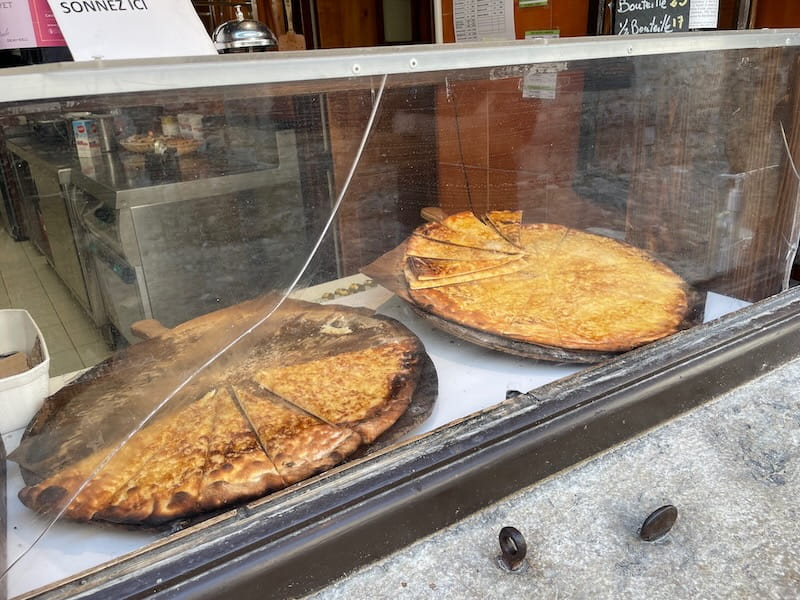 The now-famous Galette de Pérouges ©OffbeatFrance
The now-famous Galette de Pérouges ©OffbeatFranceTOP SUMMER TIPS IN PÉROUGES
- Festivals, medieval reenactments and open-air concerts in the ancient square
- Sweet scent of its famous galette
- You'll be walking through history, in a village that feels frozen in time
Watch out for: Tourists from the many tour buses from Lyon clog the narrow lanes, and the cobblestones can be slippery in the heat when dust settles. Arrive before 10am or after 4pm to dodge the worst crowds. Wear sturdy soles for uneven terrain. If you're staying in Lyon, visit on a weekday to avoid local weekenders.
7. Yvoire
In summer, Yvoire bursts into bloom — crimson geraniums spill from every window, ivy climbs ancient stone façades, and the village shimmers on the shores of Lake Geneva. It’s easy to see why Yvoire, once a 14th-century fortress and later a sleepy fishing village, now draws in the crowds.
The castle is private, but the Garden of Five Senses is open — and unforgettable. The cobblestoned streets lead past galleries, medieval gates, and cafés where perch fillets come straight from the lake.
It’s a short hop from Geneva by boat, but far enough to feel like another century — and another country, of course.
After the last ferry leaves, the village begins to breathe again. Stay the night if you can at the Hôtel du Port, and eat a plate of their perch fillets drowned in lemon sauce.
I lived here for a while and hid away during the day, emerging in the evening for the fresh lake breeze and some delicious al fresco dining.
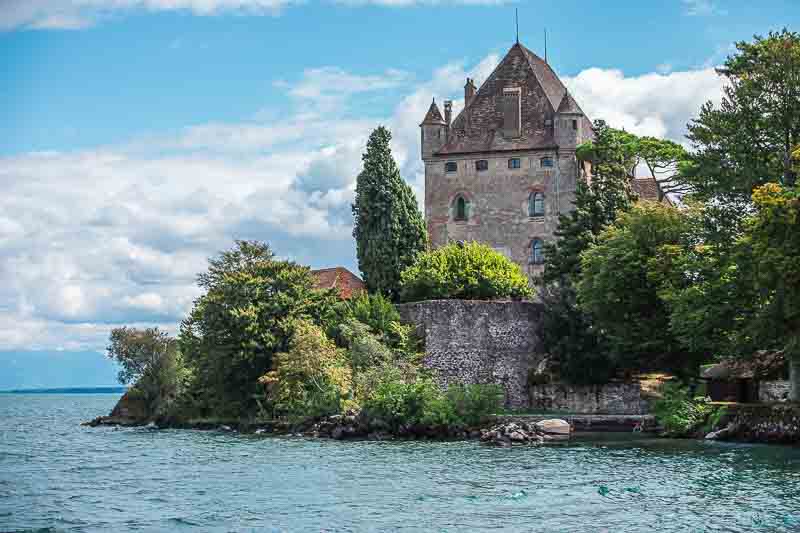 Yvoire's castle, seen from Lake Geneva when arriving by boat
Yvoire's castle, seen from Lake Geneva when arriving by boatTOP SUMMER TIPS IN YVOIRE
- Fabulous flower displays throughout the village
- Lake breezes
- The ramparts and the lakeside are at their most photogenic
- All restaurants and art galleries are open
Watch out for:
It’s highly touristed in July and August, and parking fills up early. It can also be surprisingly expensive, since it's right next to Switzerland. Take the ferry from Nyon or Geneva or arrive early by car. While eating by the lake in Yvoire is romantic, you'll find good food and better prices a bit inland. Consider visiting on a weekday and pair it with a swim in the lake or a garden walk to balance the crowds.
Before you go...
There are so many beautiful small villages in France that to see them all would be an impossible dream. But this bright summer list is a beginning, and I'll keep adding to it.
There are plenty of other perfect summer destinations in France, so why not experience some of these 10 spectacular destinations if you're visiting in June?
And finally, if your mood is more city than village, consider visiting some of the most gorgeous cities in France — but again, summers can be crowded and hot so if you can, spend the night so you can enjoy the cities in the evening and in early morning.
Did you enjoy this article? I'd love if you shared it!

